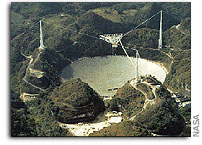Division for Planetary Sciences (DPS), American Astronomical Society

The National Science Foundation has released the report of its senior review committee on the future support of national astronomical facilities; see http://www.nsf.gov/mps/ast/ast_senior_review.jsp for more details.
Among other recommendations, it suggests that support for the Arecibo radio telescope be scaled back, and that the eventual decommission of that facility should be investigated. Given the already flat budget for Arecibo over the past few years, it is quite possible that the S-band radar system, heavily used by planetary scientists, may soon be eliminated. Given the importance of this system to planetary scientists, on November 13 the chair of the DPS has sent the following letter to Dr. G. Wayne Van Citters, director of the Division of Astronomical Sciences at the NSF:
Dear Dr. Van Citters,
It is with great interest that I have read the report of the National Science Foundation senior review committee, From the Ground Up: Balancing the NSF Astronomy Program. Recommending the eventual decommissioning of a telescope or system is never a pleasant task, and I respect the honesty with which this commission approached these hard choices.
However, given the complexity of the issues it is inevitable that some aspects can get overlooked. In this regard, noting that the senior review committee did not have representation from the planetary sciences community, I must point out that the discussion of scaling back and possibly decommissioning the Arecibo telescope appears to have overlooked an aspect of its work that is in fact of major importance to the planetary community: its unique abilities as a tool in studying solar system bodies, especially near Earth asteroids, by radar.
There is in fact only one reference to radar in the entire 78 page document, and no mention at all of asteroids. But the Arecibo radar results are key to understanding near earth object sizes, shapes, and dynamics. Besides having a central scientific importance, both of themselves and as samples derived from the main asteroid belt, near earth asteroids may represent a significant hazard to Earth and also a potential source of future resources. To decommission one of our primary tools for studying them would deal a serious blow to both our science and our safety.
I note, finally, that the recommendation in this report to limit future NSF funding of Arecibo is based on the eventual run-out of current ongoing radio astronomy survey work. As noted before, the report says virtually nothing about radar, much less recommending its elimination. Thus we feel especially disconcerted that, although the Arecibo administration has indicated that it will make every effort to seek other sources of support, the NSF funding cut to $8M/yr allows operation of the S-band planetary radar system only until 30 September 2007. Ending the operation of the S-band radar, the basis of a vibrant program as indicated by its 40% share of recent Arecibo abstracts and so important especially for asteroid studies, does not follow either the spirit or the letter of the recommendations in the NSF report. Speaking for the planetary sciences community and the AAS Division for Planetary Sciences, I strongly urge that this proposal be reconsidered.
Sincerely yours,
Guy Consolmagno SJ,
Chair, Division for Planetary Sciences of the American Astronomical Society
Vatican Observatory; Loyola Chair 2006-2007, Fordham University
DPS is the largest organization of planetary scientists in the world. Approximately a third of its membership is from other countries.
For more information about Arecibo Observatory, please visit: http://www.naic.edu/public/descrip_eng.htm









